Oslo - capital city of Norway
Oslo is Norway's capital and largest city, with 700,000 citizens in the city proper and about 1.5 million inhabitants in greater Oslo. It is in the East of the country in the Oslofjorden fjord, extending over an inlet of the Skagerrak strait. It is spaciously laid out and surrounded by green hills and mountains and includes 40 islands and 343 lakes. Oslo offers ski slopes for alpine skiing and ski trails for cross-country skiing in the winter. In the summer, the temperature in Oslo may make it comfortable to swim. There are several well-visited beach resorts. Oslo is one of the world's northernmost capitals and so gets only 6 hours of sunlight in the winter. In high summer, sunlight hours soar to 18, making its climate markedly different between seasons, with cold yet relatively dry winters.
A relatively compact city squeezed into a thin strip of land along the shoreline, Oslo prides itself as one of the world's most sustainable cities. Central parts of the city are compact, but Oslo as a whole is relatively spacious. While it holds an array of historic monuments, Oslo is perhaps most famous for its modern architecture, including striking and daring projects launched at the turn of the millennium. Oslo's economy is powered by the maritime industry, high-tech and clean energy sectors. In 2010, Oslo was ranked as the world's most expensive city to live in by the Swiss wealth management company UBS AG.
Oslo is Norway's economic and demographic centre, as well as the hub for most domestic and international transport. Despite Oslo's population density there is never more than 300 meters' walk to a park or green area from any residence in the city.
Districts
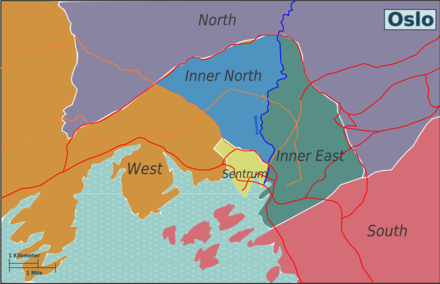
Downtown Oslo with main sights, restaurants and hotels, and the harbor (Oslo City Hall to the Opera House).
West (Frogner, Ullern)
Several major museums, Bygdøy, the Vigeland sculpture park, high end shopping and dining.
Just north of downtown you will find several parks, eateries, industrial heritage and the main campus of the university.
The more bohemian part of Oslo is the place to go for alternative culture and international dining. East of the Akerselva river.
The northernmost part of the city is largely forest. If visiting the city and you want to see some nature as well, this is the place to go.
Comprising the east bank of the Oslo fjord and the islands, also the southern outskirts of the city is for outdoor fans. In the summer, the beaches here are really popular.
Understand
.jpg/440px-Stortinget,_Oslo,_Norway_(cropped).jpg) Oslo is the demographic, economic and political centre of Norway. As the capital of Norway, Oslo hosts several national institutions within government, education, culture, sports and transport. The city has a good selection of cultural institutions and a good selection of restaurants, some world class but most ordinary, as well as night life in general. While it is an expensive city for overseas visitors, many of the best things are free of charge, notably Oslo's proximity to wild nature, inner city parks and variety of outdoor activities.
Oslo is the demographic, economic and political centre of Norway. As the capital of Norway, Oslo hosts several national institutions within government, education, culture, sports and transport. The city has a good selection of cultural institutions and a good selection of restaurants, some world class but most ordinary, as well as night life in general. While it is an expensive city for overseas visitors, many of the best things are free of charge, notably Oslo's proximity to wild nature, inner city parks and variety of outdoor activities.
Metropolitan Oslo also includes most of Akershus county and the line between these is so blurred that the two is seen as one city. Local public transport such as the Oslo metro covers Oslo proper and the surrounding districts. Oslo proper has over 700,000 inhabitants while metropolitan Oslo has well over 1 million inhabitants. Oslo's influence is felt well beyond the metropolitan area and the wider "Oslo region" includes the densely populated lowlands around the inner Oslo fjord and the flatlands around the airport. This region covers only 5% of Norway's area but has 25 to 30% of the population.
Name and history

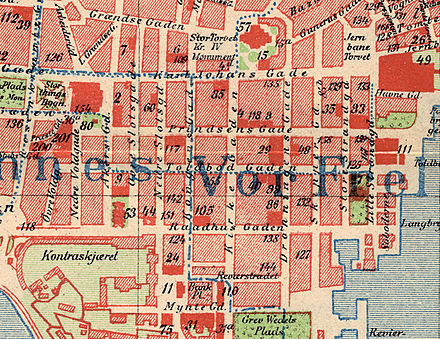
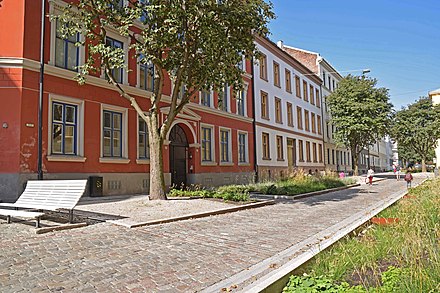
 See also: Vikings and the Old Norse
See also: Vikings and the Old Norse
The history of the city can be traced back to at around year 1000. Oslo was according to the ancient saga founded by king Harald Hardråde in 1048, and became a diocese in 1070. The city became the capital of Norway around 1300, but lost its privileges during the Danish-Norwegian union from 1348 to 1814. In 1624, a fire devastated old Oslo, and the city was moved some kilometres west to gain protection from the fortress at Akershus. The new city was built in a strict grid plan that still appears modern, this area is now within downtown Oslo (between Akershus fortress and Oslo cathedral) and known as Kvadraturen. The expanding city Christiania was built on the land of the Aker estate so the river and the oldest church are "Aker" river and church respectively. Christiania developed west of the Aker river, while Old Oslo became a backwater between Alna river and Ekeberg hill.
The new city was named Christiania, after the Danish King Christian IV, a name that remained until it was officially named Oslo on 1 January 1925 to remove the Danish name. Old Oslo, which had retained its name since the middle ages, was then renamed Gamlebyen ("Old town") to avoid confusion. In Gamlebyen there is a Oslo street, Oslo square and Oslo hospital. The original town Christiania built in 1624 is now called Kvadraturen and is the oldest part of Oslo. Traces have been found close to Ekeberg indicating settlement as far back as 10,000 BC. After the 1624 fire Oslo/Christiania was built exclusively from brick and stone; this gives a city clearly different appearance compared with wooden towns like Bergen, Stavanger and Trondheim.
After the devastating 1624 fire, old Oslo (around the mouth of river Aker) was largely abandoned and the ruins converted to farmland. Today, a few church ruins are still visible under the Ekeberg hill (across the water from the new opera house, between road E18 and the railway). Beyond these ruins virtually nothing remains of medieval Oslo. The new city Christiania was established outside the borders of Oslo, and 'Oslo' remained the name of the small, surviving settlement outside the new city borders. During Christiania's rapid expansion in the 19th century, as the capital of a new state, the site of original Oslo (old Oslo, or 'Gamlebyen') was included in the city. Due to the rapid inclusion of surrounding agricultural areas in the 19th century, many remnants of the city's farming history are still clearly visible in place names and farmhouses. The remains of historical pastures can be found at parks such as St. Hanshaugen.
In 1814 Christiania became the capital of the new state under the Swedish crown. The city was still a small town with a few thousand inhabitants, notably smaller than Bergen. During the 1800s Oslo expanded rapidly to become a big city. In 1850 there were some 30,000 people living in the city, by 1900 this had grown ten-fold, and by 1950 Oslo had more than 500,000 inhabitants. In the 1800s cities in Norway were largely built from wood. From around 1850 Oslo became Norway's only masonry city. Buildings in expanding city was modeled after major European cities, notably Berlin and other German cities. Oslo was for some time known as Little Berlin because of the similarity in architecture. The city council made masonry mandatory and the city was developed with compact blocks and four to five levels. This was a radical departure from traditional Norwegian style with small wooden buildings. Architects were trained in Germany and Danish and German craftsmen took part in the boom.
The late 1800 masonry buildings and style are largely retained and much better preserved than in Berlin (largely because of the destruction during World War 2). Some 3000 blocks from that period gives Oslo a unique character. Key areas within central parts Oslo are still dominated by this style. For instance Grünerløkka, Frogner, Majorstua, St. Hanshaugen and around the Royal Palace. During the rapid expansion during the 1800s previous farmland outside the city gates belonging to city dwellers was included in the city. Enclosed farmland or gardens were called løkke and neighborhoods in these areas kept these names for instance Rodeløkka (named after Fredrik Rode) and Grünerløkka (named after Friedrich Grüner).
When Oslo became Norway's capital several building and city development projects began to host national institutions. The striking result is the upper part of Karl Johan street where the parliament building and the royal palace sits at either end. The government building complex in Akersgata were added later perpendicular to the Karl Johan axis. The supreme court building is next door. When the railway age came to Norway Oslo got one station in the east (the current central station) and one in the west. Trains now run in a tunnel under the centre and the west station building now hosts the Nobel peace centre at the entrance to Aker Brygge.
The rapid expansion in the late 1800s was particularly related to the heavy industry around Akerselva (river) - the river and waterfalls provided water and power to the factories, ship building along fjord notably what is today Aker brygge was also important. Today most heavy industry has left the city. The characteristic red brick factory buildings are largely preserved for instance along Aker river and are interesting sights for instance in the Sagene (literally Saw mills) neighbourhood. Akerselva was in the middle ages called Frysja ("the cascading one") referring to the many small waterfalls. There are some 20 waterfalls.
Modern competitive skiing was developed in Oslo. Ski jumping, cross-country skiing and downhill/slalom races have been held in Oslo since 1866. Downhill/slalom were further developed in the Alp region and then got the name "alpine skiing". This strong tradition is visible in the imposing Holmenkollbakken (a ski jumping venue) and a fine network of cross-country tracks throughout the Oslo forest, as well as the skiing museum.
Since 1947, Oslo has given a big Christmas tree to London in gratitude for the help and support to Norway during World War 2. The tree is prominently displayed on Trafalgar Square and decorated in Norwegian style.
While Oslo has been a safe city in modern times, the government district was hit by a terrorist bomb blast in 2011, killing eight people. The damaged buildings have not been replaced (as of 2020).
Geography
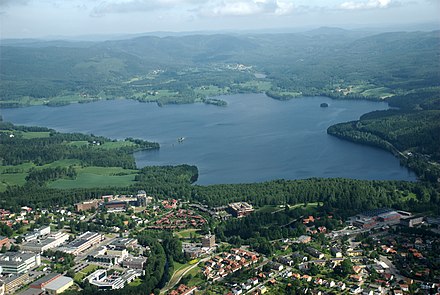 Oslo, with its approximately 453 km², is one of the largest capitals in the world by area, but most of it is forest, making Oslo a city in close contact with the nature surrounding it. If major suburbs outside city limits are included, metropolitan Oslo covers an area similar to Greater London but with only one tenth of London's population. The Oslo fjord extends northwards from the Skagerrak sea. Oslo has an impressive archipelago of islands, which in summer becomes the city's favoured playground. The Oslofjord has very little tide, about 50 cm only.
Oslo, with its approximately 453 km², is one of the largest capitals in the world by area, but most of it is forest, making Oslo a city in close contact with the nature surrounding it. If major suburbs outside city limits are included, metropolitan Oslo covers an area similar to Greater London but with only one tenth of London's population. The Oslo fjord extends northwards from the Skagerrak sea. Oslo has an impressive archipelago of islands, which in summer becomes the city's favoured playground. The Oslofjord has very little tide, about 50 cm only.
Oslo is situated in an amphitheatre-like setting, with the city centre in the bottom close to the Oslo fjord, and residential areas stretching uphill from there in all directions. Central Oslo is relatively even and stretches from sea level to about 100 meters above sea level, but the settlement stretches to almost 500 meters above sea level. The city is surrounded by forested hills known as Marka (Nordmarka, Østmarka, Lillomarka), with flora and fauna that is quite extraordinary for a city of this size. Moose are commonplace (easily spotted in winter), and the whole of the capital is part of Norway's wolf reserve (even if they rarely come here).
The city centre is bounded by Oslo Central Station (Oslo S) to the east, the Royal Palace (Slottet) to the west and the seafront (from Akershus fortress to Aker brygge) to the south. It's fairly compact and easily walkable. Karl Johans gate, the mostly pedestrian main street connecting Oslo S and the Palace, is the main artery of downtown Oslo. However, several of the neighbourhoods close to the centre hold interesting sights and entertainment offerings, so to explore these you should make use of the city's comprehensive public transport system.
European Green Capital 2019
The city of Oslo has been recognized as the European Green Capital for 2019. This means that the city is in a process of achieving the global goals for a better climate and to minimize the air pollution and the water pollution within the city. There is also a strong focus on reuse to reduce litter. Maximum environmental friendly transport is also one of the ambitions. Read more about the environmental initiative here.
Climate
Although well into the northern latitudes, Oslo's climate is fairly temperate thanks to warm air being wafted across the Atlantic from the Gulf Stream. Summer weather in Oslo is mild and pleasant, with frequent hot spells with daily highs above 25°C or up to 30°C, and plenty of long sunny days - at midsummer the sun rises at 4 in the morning and sets at 11 in the evening. There is almost two hours twilight in summer so nights are hardly dark. There is moderate precipitation (about 800 mm), December to June is the driest period. December to February temperatures are on average just below freezing, while in November and March temperatures hover just above or below freezing. Temperatures are rarely below -10°C downtown and can occasionally drop to -20 °C. Snow is most often plentiful in the forested areas and also often in the city in winter, making it a great winter sports venue. Rainfall is spread across the year, the rainiest month being August.
People
Oslo proper has a population of 647,000 people, or close to 1 million when including its extra-municipal suburbs (such as Bærum and Lørenskog). The Oslo metropolitan area has a population of around 1.4 million. The diverse population includes some of Norway's wealthiest celebrities and socialites, as well as more than 150,000 immigrants. This has made Oslo a highly ethnically and culturally diverse city, with 28% of the city's population having an immigrant background. Accompanied by a large influx of people from all around Norway, Oslo is thus often referred to as the "melting pot" of Norway. Cultural differences have affected Oslo's society and cityscape in matters of for instance dining and shopping, which have all blended in to the everyday life of Oslo's population. Some areas of Oslo, especially around Grønland and Tøyen, and many suburbs east of the city centre, have majority-immigrant or majority non-ethnic Norwegian populations. Depending on the area, the most notable immigrant communities are Pakistani, Swedish, Polish, Somali, Sri Lankan, Iraqi, Vietnamese, Iranian, ex-Yugoslavian, Moroccan, Turkish, Albanian, Filipino, Thai and Danish. Pakistani immigrants and their descendants form the largest minority group in Oslo.
Economy
The Oslo region is the country's premier business centre and has a diverse and dynamic economy with one of the highest regional GDPs in Europe. Figures published by the regional development agency for Oslo show that GDP per capita in the region was €44,190 (excluding oil and gas) in 2000, compared to an EU average of approximately €20,000. According to a report produced by the city's Chief Commissioner's Department and the Department of Finances and Development, the service sector dominates employment in Oslo. In 2001, Public and Business services accounted for more than 59 percent of jobs. Other major employment areas within the service sector include trade, hotels and catering, banking and insurance.
.jpg/440px-Lh%C3%B4tel_de_ville_dOslo_(4854168964).jpg)
Orientation
Following the latest reform of January 1, 2004, the city is divided into 15 boroughs (bydeler). Most tourist attractions are concentrated in the city centre (Sentrum). Some other districts of note are Frogner, a hilly residential district with the namesake park famous for the Vigeland sculptures in the West, and Grünerløkka in the Inner East, hub for nightlife and the creative scene.
Traditionally, Oslo has been divided into the eastern and western parts, with the West being the more affluent, with elegant buildings and a posh character, and the East consisting of working-class neighbourhoods, growing into a home for both the artistic bohemian and poor immigrant communities.
For the short term visitor, navigation is typically related to key buildings and streets in the centre. Karl Johans gate (known merely as Karl Johan) is Oslo's main street and runs from the railway station passed and towards the Royal Palace. Key buildings are concentrated around this street, notably the University, the Nationaltheateret, the Cathedral and Stortinget (Parliament). In the adjacent streets the City Hall, Nobel peace centre (previous West station), Ministries (government buildings), the Supreme court, and major museums. The nightlife district at Aker brygge is a short stroll from Karl Johan. The new Opera house is next door to the railway station. In addition to the Central railway station, next door to the Nationaltheateret and Palace there is the second main station underground served by airport trains, local trains and all metro lines.
Get in
By plane
Oslo is served by two airports: Oslo Airport, Gardermoen, Sandefjord Airport Torp. Oslo Airport is the largest of the two and is the main international gateway to Norway.
Most internet flight booking sites will show flights to both airports when searching for Oslo Airport. Make sure to check the actual airport from the search results before booking. Both Sandefjord Torp is located far from the city centre, and ground transportation to Oslo takes more than one hour. You should be able to tell based on the IATA code: OSL for Gardermoen and TRF for Sandefjord.
Oslo Airport, Gardermoen
For more information on facilities at and around Oslo Airport, Gardermoen, see the Oslo Airport, Gardermoen article.
Oslo Airport, Gardermoen (IATA: OSL) is Norway's largest airport, in Gardermoen, 37 km north-northeast of Oslo. Direct flights are available to 107 airports, including 24 airports in Norway. The largest airlines in Norway, Scandinavian Airlines (SAS) and Norwegian Air Shuttle, operate direct flights to many foreign destinations from Oslo Airport, and have large domestic networks. Flights by about 30 other airlines make this airport easy to reach from most of the world. In 2016 and 2017 there are extensive expansion works going on in the terminal. Some gates are replaced by buses, part of the runway is being paved and getting around the airport itself is to some extent impaired as well. If you are transferring at Oslo, don't pick a flight with a too short connecting time.
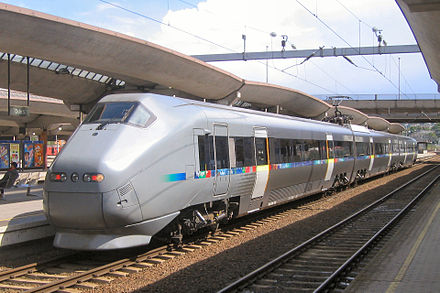 To travel between the city and the airport:
To travel between the city and the airport:
- Flytoget (Airport Express Train), operates high speed express trains, generally taking 19-22 minutes to reach Oslo Central Station (Oslo S). Trains to Oslo Central Station depart every 10 minutes on weekdays from 07.00 to 23.10, Sundays from 11.30 to 23.10, and every 20 minutes at other times (04.40-06.50 and 23.10-00.50 everyday, 07.20-11.20 Sundays, and all-day during Saturdays and bank holidays). Every 20 minutes from 05.30 to 00.50, the train also calls at Lillestrom and continues past Oslo S to Drammen, stopping at Nationaltheatret station, which is more convenient for destinations in the western end of the city center. The fare is 210 kr for most adults, 105 kr senior citizens, unaccompanied kids and students younger than 31 with a student ID, and free for under-16s accompanied by an adult. The fare can be paid for by (a) swiping one's debit/credit card on the card reader on the fare gate and selecting the destination on the touch screen, (b) buying a traditional paper ticket from the vending machine and scanning its barcode on the fare gate's reader, or (c) buying an e-ticket on Flytoget's website or mobile phone app, printing or downloading the ticket respectively, and scanning the barcode on the fare gate's reader. To use option (a) as a discounted passenger or get a receipt, one will need to create an account on Flytoget's website, register the payment card one intends to use and enter other pertinent information (e.g. date of birth). Passengers who are travelling back to the airport from the city centre and want to use option (a) will need to swipe/tap their card on the designated card reader at Oslo S before boarding the train and swipe their card again at the fare gate's card reader upon arrival at the airport.
- Vy (formerly NSB) operates trains via Oslo to Drammen, then on to Kongsberg or Skien. The trip takes 23 minutes, and trains depart 3 times per hour. This is the cheapest form of public transport to get to the city centre as a one-way ticket costs 105 kr (no discounts for students) and 53 kr for senior citizens, under-18s and military service members, and includes access to local bus services, underground trains (T-bane), and trams in central Oslo for about two hours (see Get around section).
- Flybussen (dead link: January 2023) operates buses on 6 routes from Gardermoen. Bus to Oslo city center (line FB2) which take roughly 45 minutes to reach the city center (180 kr, return ticket valid for 1 month 275 kr, valid for transfer in Oslo, cheaper fares if bought online (179 kr one-way, 260 kr return), 50% discount (95 kr one-way if bought online) for different groups, including students younger than 31). Purchase from the bus driver using your credit card. Cheaper fares if you have valid ticket for public transport.
- Taxis can, and should, be ordered in the booth inside the terminal for different fixed prices from approximately 700 NOK to Oslo city centre. Going outside to flag one from the queue can end up much more expensive. Always negotiate price in advance. Different taxi companies have different prices, Oslo Taxi is the most reliable. Most people with a destination in Oslo will be far better off getting the Flytoget, Flybussen or local train to Oslo S, and get a taxi or local public transport from there.

Sandefjord Airport Torp
Sandefjord Airport Torp (IATA: TRF) near Sandefjord and Tønsberg, 118 km south of Oslo. The following airlines operate at Torp: KLM (Amsterdam), Norwegian Air Shuttle (Alicante), Ryanair (Alghero, Alicante, Barcelona-Girona, Bremen, Edinburgh, Frankfurt-Hahn, Liverpool, London-Stansted, Milan-Bergamo, Marseille), Widerøe (Bergen, Bodø, Copenhagen, Stavanger, Tromsø, Trondheim), and Wizz Air (Gdańsk, Katowice, Poznań, Prague, Riga, Warsaw, Wrocław, Vilnius)
To travel between the city and the airport:
- Torpekspressen operates between the airport and Drammen and Oslo (1 hr 45 min) and costs 279 kr (Feb 2022) for a single ticket, 470 kr for a return (discounts for students, ISIC Card Holders and senior citizens), slightly cheaper if bought online. Torpekspressen buses are scheduled to accommodate arriving flights, so after you get off the plane, most likely there will be a bus to Oslo waiting for you. If you miss the bus scheduled for your flight, you may end up waiting a long time for the next bus.
- NSB operates trains between Torp Airport Train Station and central Oslo for 249–289kr (Feb 2022). The train station is linked to the airport via free shuttle buses.
- Nettbuss is another option but with short interchange at Sandefjord (Fokserød). Ticket price is 270-310 kr if bought online.
- Several small Polish minibuses serve flights to and from Poland. Price is 170 kr to Oslo Bussterminal or more depending on where in Oslo you need to go.
- PKS Oslo accepts both cards and cash. You can pay online or directly to the driver.
- Taxis are very expensive; a taxi to Oslo costs around 2000 kr.
By train
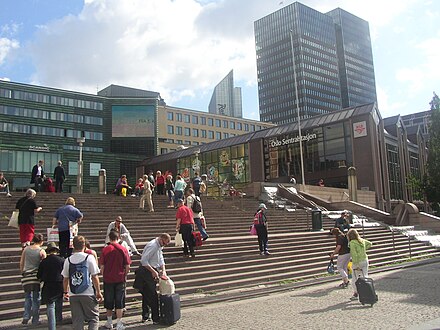 Oslo Central Station (dead link: January 2023) (Oslo Sentralstasjon/Oslo S, T-bane, tram, bus: Jernbanetorget) is at the eastern fringe of the city centre, by the end of the main pedestrian street Karl Johans gate. Oslo S is the center of rail travel in Norway as all lines (including the airport express train) terminate at Oslo S. The major express buses go to the bus station next door to the train station.
Oslo Central Station (dead link: January 2023) (Oslo Sentralstasjon/Oslo S, T-bane, tram, bus: Jernbanetorget) is at the eastern fringe of the city centre, by the end of the main pedestrian street Karl Johans gate. Oslo S is the center of rail travel in Norway as all lines (including the airport express train) terminate at Oslo S. The major express buses go to the bus station next door to the train station.
Internationally, there are four daily services from Gothenburg (Sweden) (schedule); each trip takes a little under four hours. Travelers from Copenhagen (Denmark) and beyond will need to change trains at Gothenburg.
From Stockholm trains run every two hours or so, taking 5½ hours via Södertälje, Hallsberg and Karlstad.
Tickets for the Gothenburg line are cheapest when bought at the Vy website, where the Minipris-fares run as low as 199 kr. Tickets for the Stockholm line are cheaper if you buy them from the Swedish train company SJ's website, where the cheapest tickets can end up as low as SKr 95. Tickets are released for sale 3 months ahead of departure, and the sooner you buy them the cheaper they will be. Norwegian and Swedish reserved train tickets can be picked up at ticket machines in Oslo Central Station (Norwegian tickets can also be picked up at other stations).
Norwegian state rail operator Vy (formerly NSB) runs fairly frequent and reasonably efficient, though not very fast, domestic services to Stavanger, Kristiansand, Bergen and Trondheim, as well as a relatively comprehensive, but flaw-marred, local and regional service around Oslo. Check Vy schedules for details.
Long-distance trains heading south- or westwards also stop at Lysaker station at the western city border. Those heading north and east make their first call at Lillestrøm station, outside of the city.
For people using Oslo as a point of transit, the building just south of the main central station is still part of the train station and has lockers for rent. The small lockers are 30 kr, the medium lockers are 40 kr and the large lockers are 60 kr. The medium lockers also come in two shapes, cubic and thin-and-tall, make them useful for storing luggage which would not normally fit.
By car
For more details see: Driving in Norway
International highways E6 (from Malmö and Gothenburg) and E18 (from Saint Petersburg, Helsinki and Stockholm) meet in Oslo. Driving a car to the city of Oslo is expensive and inconvenient. Both high tolls and parking fees make driving a car an expensive treat. Rather, consider setting aside your car outside the city and taking advantage of the excellent public transportation available. There is a road tax of 25 kr to enter Oslo with a car. Electric cars are free or much cheaper. The money is used for road construction and public transport. The toll booths are non-stop, and will snap a photo of your license plate and send the bill to the car owners' house. In addition, when entering the city from the west, an additional tax of 12.50 kr is charged on the municipal border at Lysaker to finance the construction of a new highway leading westwards.
The E6 is the main north-south road of Norway, and continues north to Trondheim, Alta and Kirkenes, with branches to most Norwegian cities. The E16 runs west to Bergen and east to Kongsvinger ending up in Gävle, Sweden. The E134 runs to Haugesund and the E18 lead south-west to Drammen, Grenland (Skien/Porsgrunn/Langesund) and Kristiansand. Other notable roads into Oslo include Rv4 from Gjøvik, Rv2 from Charlottenberg (Sweden) and Kongsvinger and Rv7, an alternative road to Bergen passing Gol and Geilo..
By motorcycle
Oslo is Norway's largest city, and many roads have much traffic, especially during rush hours. The traffic increases the closer you reach the city center. Local roads are often dead ends or narrow, winding with many intersections that require increased attention.
Nevertheless, motorcycles may often be the means of transport that provide the best accessibility, if you take into account safety first. Motorcycles and mopeds are exempt from paying tolls at all automatic toll stations in Norway. Good roads for motorcycles can be found here.
By bus
Oslo is well served by bus from most of Europe. The biggest operators of international buses are Swedish companies Swebus (dead link: January 2023) and Vy express. Both run inexpensive services to and from Gothenburg and Copenhagen several times a day. Swebus also run services to Stockholm. Vy Bus4you operates a luxury coach service to Gothenburg and Copenhagen.
On domestic services Nor-Way Bussekspress is the biggest operator, with several buses to Kristiansand, Bergen, Trondheim and tons of other Norwegian destinations. These are very useful for reaching along-the-way destinations, as outside of the central parts of Eastern Norway they stop at every single stop along the way, but are tedious for travelling very long distances also covered by train. Konkurrenten drives along the west bank of the Oslofjord south to Kristiansand 4-7 times daily, while Lavprisekspressen has buses to Trondheim and Kristiansand twice a day, with cheap fares (Internet booking only). Timekspressen (dead link: January 2023) runs a network of bus lines in the area surrounding Oslo, most notably their line 1 to Drammen, Kongsberg and Notodden, that runs every hour, day and night, year-round. Every town and city in Norway is somehow connected to Oslo by public transport, although connections are sparse outside the main arteries.
By boat
 Oslo is connected to Denmark and Germany by car ferry. Color Line runs services to Kiel (Germany) daily. DFDS runs daily services to Copenhagen (Denmark), and Stena Line provides service to Frederikshavn (Denmark).
Oslo is connected to Denmark and Germany by car ferry. Color Line runs services to Kiel (Germany) daily. DFDS runs daily services to Copenhagen (Denmark), and Stena Line provides service to Frederikshavn (Denmark).
You may also want to consider Color Lines high-speed boats from Larvik (2 hours south of Oslo on E18, or easily reachable by hourly Vy train) or Kristiansand (4½ hours south of Oslo on E18, or reachable on five daily trains or near-hourly buses) to Hirtshals (Denmark). They both take some 3½ hours to reach Denmark.
The train station in Kristiansand is close to the ferry quay, while in Larvik the quay has been moved to a location which is a bit of a trek from the station.
Ferry company Fjord Line operates ferries on the route Langesund (by the E18, 3 hours south of Oslo by car) to Hirtshals (4½ hours).
The cruise ports (dead link: January 2023) in Oslo are on four different Sentrum piers, from west to east: Filipstad (330 m (LOA), 8.5 m draft), west of Aker Bryyge; Søndre Akershuskai (345 m (LOA), 10.3 m draft), the main pier by Akershus Fortress; Vippetangkaia (249 m (LOA), 7.3 m draft), south of Akershus Fortress; Revierkaia (294 m (LOA), 8.3 m draft), south of the Opera House. Annually, about 200,000 cruise passengers visit Oslo from these cruise piers.
Coming to Oslo in your own boat, there are some visitor's berths in Herbern Marina at Aker Brygge (to the left of the clock tower). Be aware of passenger ferries and container ships approaching and leaving the inner harbour and the Filipstad and Sjursøya terminals.
Get around
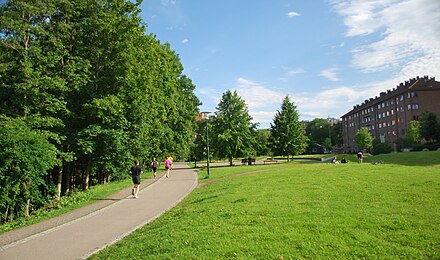 There is a comprehensive public transport system in Oslo, consisting of buses, trams, local trains, metro (T-bane) and boats. The public transport is planned and coordinated by Ruter. The five metro lines have numbers 1 through 5, the six tram lines have numbers 11 through 19, buses have labels from 20, while boats (ferries) are B1, B2 and so forth. Local trains operated by Vy are covered by Ruter ticket system. The local public transport of Oslo also covers the suburbs in Akershus, notably Bærum in the west, where the tram and metro cross the county line.
There is a comprehensive public transport system in Oslo, consisting of buses, trams, local trains, metro (T-bane) and boats. The public transport is planned and coordinated by Ruter. The five metro lines have numbers 1 through 5, the six tram lines have numbers 11 through 19, buses have labels from 20, while boats (ferries) are B1, B2 and so forth. Local trains operated by Vy are covered by Ruter ticket system. The local public transport of Oslo also covers the suburbs in Akershus, notably Bærum in the west, where the tram and metro cross the county line.
Ruter Service Center (formerly known as Trafikanten (dead link: January 2023)) is the information centre for public transport in Oslo. It is found at Jernbanetorget, just outside Oslo Central Station, by the foot of the clock tower, as well as at Aker Brygge and at Oslo Airport (Gardermoen). They hand out free maps, give information and sell all kinds of tickets. The Ruter website has timetables, maps, route planner and search engines for all city transport in Oslo, as well as all transport in the nearby counties of Akershus, Østfold, Oppland, Hedmark, Buskerud, Vestfold and Telemark. The Oslo Tourist Information Centre is in the same office at Jernbanetorget, at the rear counters.
There are two main hubs for public transport inside the city centre: Oslo Central Station (Oslo S) / Jernbanetorget and Nationaltheatret (underground). All metro lines pass these stations, all trains pass Oslo S and most trains (including the Airport Express Train (Flytoget)) pass Nationaltheatret. Nationaltheatret is most convenient for key buildings such as the Royal Palace, the National Museum, the Parliament, Oslo Concert Hall and Oslo City Hall.
Tickets and the zone system
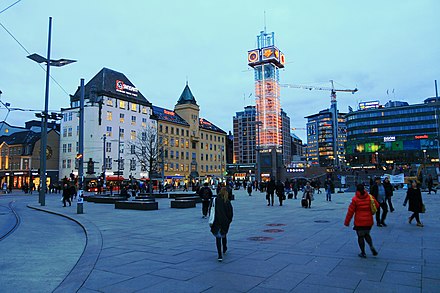
All transport runs on the same fare scheme, and the same tickets are valid for all modes of transport. A single ticket costs 39 kr when bought in advance from the app or a kiosk, and 59 kr when bought from a bus or tram driver. After being activated (validated), the single ticket is valid for one hour of free travel in the zones the ticket is valid for. You can also get a Travelcard where you load pay-as-you-go-credit for the price of a single ticket.
There are also period tickets available; 24-hour ticket (117 kr), 7-day ticket (323 kr), 30-day ticket (814 kr) and 365-day ticket (8,140 kr) for one zone. Read more about the tickets and see prices for multiple zones here.
Buying tickets with the mobile phone application is recommended, and both Apple iOS and Android is supported. Most locals use the app to buy their tickets.
All these tickets, except 365-day ticket, are half-priced for children (4–15 years) and elders (67 and up). 7-day and 30-day tickets are also half-price for youth up to and including 19. Children under the age of 4 ride for free. Children under 16 who travel with an adult travel for free at weekends. If you are bringing a bike, you must buy an additional child ticket. Student discounts for 30-day tickets are also available, but only if you are studying in Oslo or Akerhus area. Read more about discounts here: discounts here. For a short visit, one additional option is to buy a Oslo Pass which includes free admission to many tourist attractions and other benefits.
The tickets can either be bought via the mobile phone application or as an RFID chip card at the following locations (for an additional fee of 50 kr for the chip card unless you just top it up). Cards can be bought at Ruter Service Centre (Trafikanten) near Oslo S, at Aker Brygge, at most 7-Eleven, Deli De Luca, Mix and Narvesen kiosks and stores in Oslo and Akershus in addition to other kiosks and grocery shops near stops. All these tickets are also valid on the night lines, running every Friday and Saturday night after the regular service has shut down.
Make sure that you have a ticket with you when travelling and that it is validated before entering the metro platform or boarding the rear door of the bus or tram. 24-hour tickets, 7-day tickets, 30-day tickets, 365-day tickets, Travelcards, single tickets purchased in a kiosk as well as electronic single tickets are not valid until they are activated (validated). On a bus or tram, the tickets are activated (validated) when you board; activating by holding the card next to a card reader. On the metro and the large railway stations, you activate the ticket before entering the train. There are no checks getting on to T-banes, trams or buses, but if you choose to ride ticketless look out for inspectors as random spot checks are common and being caught without a valid ticket leads to an automatic fine of at least 750 kr. (Read more about ticket control) Mobile tickets purchased through the Vy or Ruter app are validated by tapping the corresponding button on the app; they do not need to be scanned against a reader (except during the random spot inspections when requested by the inspector).
All of the tickets are now only available as electronic tickets, on an electronic travel card (dead link: January 2023) or on an Impuls card (for single tickets and 24-hour tickets).
These tickets are not valid on the Airport Express Train (Flytoget), the Airport Coach (Flybussen and Flybussekspressen) and Timekspressen, each of which are operated by companies other than Ruter or Vy.
By metro
Oslo has a fairly large metro system (subway) consisting of 5 lines. It is known as the Tunnelbane or mainly just T-bane in Norwegian. The metro covers the city centre core and a large part of the suburbian residential areas. The metro does not cover popular areas close to the city centre such as Bislett, St. Hanshaugen, Frogner, Grünerløkka and Sagene. These areas are easily reached by bus or tram.
 To find a T-bane station, just look for the blue and white logo with a "T" within a circle. There are five lines, but the network is easy enough to figure out: all lines merge to one single tunnel through the city centre, from Majorstuen through Jernbanetorget (Oslo S/Oslo Central Station) to Tøyen, and then spread out into the suburbs. A loop line runs in a circle from northern Oslo city centre to the centre and back. The loop line is called "Ringen" (the ring) in Norwegians. As of 2016 Ringen (line 5) travels and extra loop through the centre on its way to Sognsvann and Vestli. Despite the name the metro trains run mostly on the surface, only through the centre the metro tracks and stations are completely underground.
To find a T-bane station, just look for the blue and white logo with a "T" within a circle. There are five lines, but the network is easy enough to figure out: all lines merge to one single tunnel through the city centre, from Majorstuen through Jernbanetorget (Oslo S/Oslo Central Station) to Tøyen, and then spread out into the suburbs. A loop line runs in a circle from northern Oslo city centre to the centre and back. The loop line is called "Ringen" (the ring) in Norwegians. As of 2016 Ringen (line 5) travels and extra loop through the centre on its way to Sognsvann and Vestli. Despite the name the metro trains run mostly on the surface, only through the centre the metro tracks and stations are completely underground.
With rolling stock from the 1960s, the Oslo metro used to be one of the most run-down in Europe, but it has now been fully replaced with new metro trains engineered by Siemens and designed by Porsche. The T-bane is a fast and comfortable way to move around Oslo. Trains are notably wider than most metros and are spacious with good capacity.
When entering a T-bane station, make sure to pick the correct platform: all stations except three on the loop line (Sinsen, Storo and Nydalen) have separate entrances and separate platforms for trains going west and trains going east. Because the lines of the Oslo metro share tracks and platforms line number and destination are indicated on each train instead of at the platform as is common on many other metros. So the line numbers actually refer to the trains and not the tracks. There are also automated information panels with real-time information the destination, line number and expected arrival of the next train. Make sure to get on the right train. The six stations in the centre (Tøyen to Majorstuen) are served by all lines. The northeastern Groruddalen suburbs (from Vestli terminal station) are served by line 4 and 5 on the same track, while they split of after Økern station. Note that on Line 1 the doors in the last segment of a train will not open between Frøer and Frognerseteren (which includes Holmenkollen) because the platforms are too short.
If you have an electronic ticket, you should theoretically validate the ticket before entering the train; however this is not yet enforced rigidly (but the ticket must still be valid (activated)).
By bus or tram
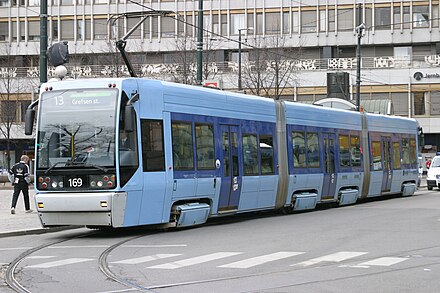
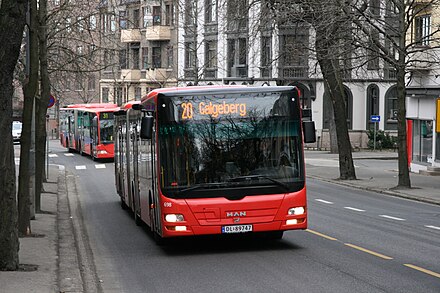 Trams (dead link: December 2020) and buses (dead link: December 2020) complement the metro network, and use the same tickets. They cover most of the city, and run from approx. 05:00 to 00:00, on some lines up to 01:00. Two bus lines, 31 and 37, runs all night, every day.
Trams (dead link: December 2020) and buses (dead link: December 2020) complement the metro network, and use the same tickets. They cover most of the city, and run from approx. 05:00 to 00:00, on some lines up to 01:00. Two bus lines, 31 and 37, runs all night, every day.
All tram lines run every 10 minutes during the day, and every 20 minutes at night and early morning (30 min at weekend mornings). The main lines cover parts of the city with no metro, and are an efficient way of getting around. The main, central tram terminal is at Jernbanetorget, where all lines converge. The six tram lines are 11, 12, 13, 17, 18 and 19. By 2020, the tram network will be upgraded and on some stretches there will temporarily be bus instead of tram "buss for trikk". The oldest (1982) trams are still running (as of 2020) and are relatively comfortable, but there are stairs to get inside. The city of Oslo has purchased brand new trams that will be operational in 2020 or 2021. Trams roll gently around the city with big windows and is a fine way of sightseeing.
Bus lines cover the rest of the city, as well as several ring lines. Nearly all central bus lines converge at Jernbanetorget. The most useful bus lines for visitors are buses 30, 31, 32, 34, 37 and 54, passing by Jernbanetorget and covering parts of the city with no tram or metro lines. Buses 20 and 21 provide central ring-line service, while buses 23 and 24 cover the highway ring road further out. City buses have a deep red color.
Nights after Fridays and Saturdays, night buses (dead link: January 2023) cover parts of the city with varying frequency. Most of these start or pass by the bus stops close to the Parliament building (Stortinget) and Jernbanetorget (Oslo Central Station/Oslo S). All regular tickets are valid.
Refer to the bus and tram route maps for more information.
By train
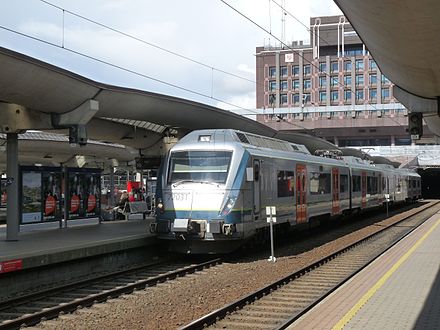 Local trains (the Vy (formerly NSB) lines L1, L2, L3, L12, L13, L14, L21, L22) cover certain areas of the city (zone 1), and run out to the neighbouring municipalities and towns. The local train network spans across the city limits to neighbouring cities and towns. The local trains use the same tickets as the metro, trams, and buses within Oslo and Akershus counties, but a different pricing scheme is used on journeys beyond that.
Local trains (the Vy (formerly NSB) lines L1, L2, L3, L12, L13, L14, L21, L22) cover certain areas of the city (zone 1), and run out to the neighbouring municipalities and towns. The local train network spans across the city limits to neighbouring cities and towns. The local trains use the same tickets as the metro, trams, and buses within Oslo and Akershus counties, but a different pricing scheme is used on journeys beyond that.
Some of the cars on local trains have orange doors, with the notice "Ubetjent" and "Carriage without Conductor". These cars are usually not visited by the conductor (except during inspections), and you can use these cars only if you have a ticket which is stamped or pre-validated, and does not need to be stamped by the conductor. You may be fined 900 kr if you use one of these carriages without, say a single ticket, and a conductor does come to check your tickets. If you are unsure about the rules, play it safe and ride in one of the carriages with black doors and notices marked "Betjent" and "Carriage with Conductor".
In the centre, the main station is Oslo Sentralstasjon (Oslo S), which connects to the metro station Jernbanetorget through a direct link (escalators down by track 1/exit to Oslo City shopping centre/bus terminal) and most bus/tram lines above ground. The second downtown station, served by most local trains and several regional ones, is the underground station Nationaltheateret, and is located immediately below the metro station of the same name. Most westbound buses also stop just outside the station.
Punctuality, especially in the winter, can be an issue as the train system is quite run down. However, things have improved since a big program of refurbishment was started in 2010. Regular Ruter tickets are valid on the Vy trains, but not on the Airport Express Train (Flytoget), which cannot be used to commute solely between points that do not involve the airport.
By boat

The islands in the Oslofjord are served year round, although there are only a few departures wintertime. The regular Ruter tickets are valid on these boats.
From March to October a passenger ferry runs from Aker Brygge to Bygdøy, with many major museums. Pre-purchased tickets from the ticket office cost 45 kr one way, or 65 kr for a return ticket. One way tickets may also be purchased on board but cost 60 kr. The Ruter tickets are not valid on the Bygdøy Ferry, but the Oslo Pass is.
From Aker Brygge, there are also departures for Nesodden and Slemmestad. These run out of Oslo, and are not covered by the Oslo tickets. However, they provide a cheap cruise on the Oslofjord.
By bike
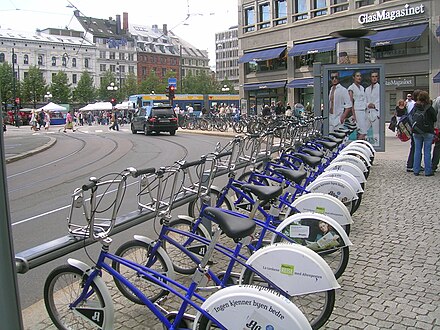
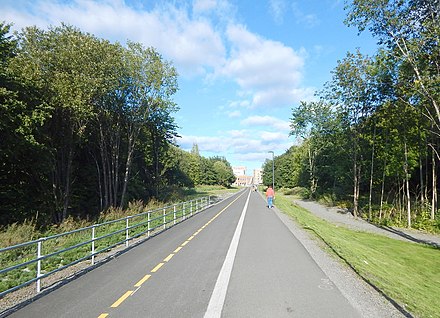 Oslo has a public bike service which operates from approx. March to November (closed when it's snowing). Bike stalls are placed in many areas of the city, and this is where you rent and return your bike. Using the Oslo Bysykkel app, you can view all stalls with the number of available bikes and locks in real time, and also unlock a bike when you're close to a stall. You can also visit the tourist information to get a pass.
Oslo has a public bike service which operates from approx. March to November (closed when it's snowing). Bike stalls are placed in many areas of the city, and this is where you rent and return your bike. Using the Oslo Bysykkel app, you can view all stalls with the number of available bikes and locks in real time, and also unlock a bike when you're close to a stall. You can also visit the tourist information to get a pass.
Available passes and prices change every season, but traditionally you could get both for a day and for the whole season. You can use the bike for 60 min, and extend up to 6 hours paying 6 kr per 15 minutes. Once returned, you are eligible for a new rental immediately, meaning you can cycle for hours as long as you return it every 60 minutes to a stall.
There is also a bike tour company in the downtown (Viking Biking) which offers rentals on new DBS comfort hybrid bikes with different sizes for men, women and children. In addition to rentals, it is possible to take guided bike tours.
Around year 2020 many new bicycle lanes were added to streets inside Oslo (at the same street parking space removed) making cycling easier. Cycle routes through the city are numbered to make navigation easier. There are also joint pedestrian and cycling paths.
By taxi
Taxis are expensive. Prices vary, however, between the taxi companies. The minimum charge with most companies is at least 80 kr, increasing to a whopping 160 kr late at weekend nights. Short central hops cost upwards of 100 kr, so if public transport still runs, use it. Taxis in Oslo as in most of Norway are frequently new, large and comfortable cars like Volvo or Mercedes. Most taxis wait for customers in a line in front of hotels or train stations, or you can order one by phoning one of the handful of taxi companies (for an extra charge). You can also flag one from the street, or go to a taxi stand.
Several companies compete to have the most incomprehensible price structure. All taxi companies have a starting fee (0-160 kr) and a fee per kilometre that varies from 14-30 kr. These fees vary by taxi company and time of day. Usually, there's three different rates: The lowest one is the day rate, usually between 06:00 and 18:00. The next is the evening and night rate, usually 18:00-06:00 Monday to Friday and 06:00-18:00 on Saturdays. The last rate is usually for Saturday night after 18:00 until Monday morning at 06:00, but different companies do have different time frames. Beware that some companies will operate with a special holiday rate (helligdagstakst) on public holidays, including the night before, which will result in staggering rates.
Taxi drivers in Oslo aren't a particularly jolly breed, but they usually do not speed too much, and taxi-crime towards customers is almost non-existent (towards tax authorities, however, is a different matter). Sometimes a taxi driver will attempt to charge you extra for luggage, and some companies do have a surcharge for this. The price structure should be shown on a sticker inside the car, but is always in so small print, and with an overwhelming amount of detail, you can't possibly decipher it. Another thing that often disturbs visitors is that the taxi drivers' name and license is not printed inside the car itself. If you encounter any problems, ask for a receipt which will help you identify the car later, or make a note of the taxi licence number on the car roof.
All taxis accept Visa and MasterCard, and the card should be swiped in the meter at the start of the journey for card validation. The driver will usually keep the card on top of the meter so that you can keep an eye on it. If you are uncomfortable with this, it is possible to ask to get the card back, but the card needs to be swiped again when you arrive at your destination. Most meters are just swipe and sign, but some companies have EMV chip terminals where you'll need to authorize the charge with your PIN. There have been no known scams connected to credit card fraud in taxis.
Some people tip taxi drivers, or round the bill up to the nearest 10kr, but taxi drivers do not generally expect a tip - most people pay the exact amount by card anyway.
Taxi companies in Oslo
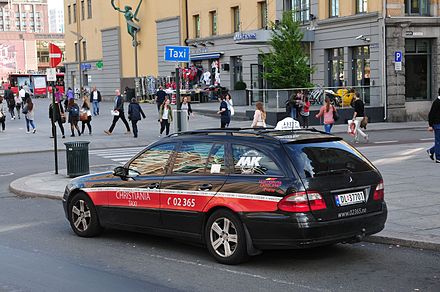
- Uber. 2020-07-09
- Oslo Taxi, 02323 (in country only), +47 22388090.
- Taxi 2, 02202 (in country only), +47 33308747.
- Christiania Taxi, 02365 (in country only), +47 22578000.
- Norgestaxi, 08000 (in country only), +47 910 08000.
- Bislet limousine, +47 22672267.
- Premium Limousine, +47 40168898, post@premiumlimousine.no. 2019-11-24
Taxi app
By using the Taxi app Vy is an easy way to order a taxi in the Oslo area. This independent app compares prices from different companies.
- Norgestaxi. Smart phone app offers address based routing and calculates price according to them. 2020-08-21
- Bolt Oslo. 2020-12-17
- Jip. Smart phone app offers address based routing and calculates price according to them. 2021-02-17
- Yango. Yango is a Russian company which offers cheap fares. 2021-07-25
By motor vehicles
For more information on driving, see the Driving in Norway article.
The major roads entering Oslo is also used for travel inside the city. In the eastern suburbs, road E6 is the main north-south corridor. East-west transport can be done on road E18 as well as Ring 3 running from E18 at the western city border to E6 in the eastern suburbs. The smaller (and slower) Ring 2 connects Skøyen in the west via Majorstua, Ullevål general hospital and Carl Berners plass to E18 east of the centre. The ring roads (as well as other main roads) are great for navigation.
Always give way to trams and pedestrians, unless overridden by signs or traffic lights. Never challenge the tram, they have a long braking distance and will in any case give a loud, clear warning if you are obstructing. In some roundabouts the tram is driving straight through the island while cars must circle, be extremely careful in this type of roundabouts: trams come from the left hand side in roundabouts. Trams are not obliged to yield to pedestrians, while cars must. Park your car in safe distance from the rails as not to obscure the tram (ask locals if unsure). Trams need up to 1.3 meters space on each side of the track.
Parking in the inner city is often difficult or expensive. Electric cars can park for free on parking meters in public streets (applies to all of Norway), while "hybrid" cars including "plug-in hybrids" must pay (as of 2016). In the city center there are some specially equipped parking spaces for motorcycles. "Mot avgift" means that there is a fee for parking. While parking on public streets in Oslo is generally allowed, gradually fewer places are available as streets are redesigned to improve movement for tram, pedestrians and bicycles. In inner Oslo many traditional buildings have gates that just look like big doors and parking in front of these gates is illegal.
See
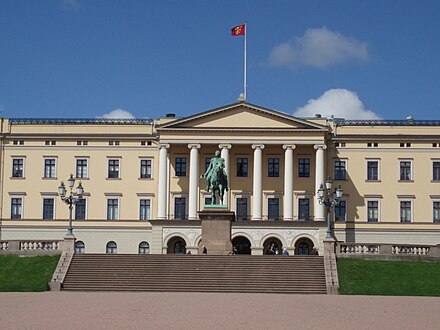
Buildings and structures
Architecture in Oslo may at first seem dull. Unlike Stockholm, downtown Oslo has only scattered monumental buildings where in particular the Parliament-Palace axis (upper part of Karl Johan Street) has a certain grandeur. This central area and the public buildings there were designed after Oslo became the capital of Norway in 1814. The charm of Oslo can also be found in the affluent inner-city suburbs of for instance Frogner and Fagerborg as well as above St.Hanshaugen park. The districts surrounding the very centre is characterised by the city's rapid expansion after 1850. These areas were developed when horses were still the most important transport, and blocks of flats from this period usually has a gate (known as port) from the street into the back yard where horses were kept. Oslo also has many exciting building projects, and the city's whole waterfront is undergoing a thorough change.
The streets of Oslo are famous from films and TV series such as Skam and Beforeigners (see Nordic Noir).
- Northern Europe has a distinct wooden house tradition. Wooden houses are not allowed downtown, but these charming houses can be found in large numbers in villa suburbs such as Bygdøy and Holmenkollen, or former workers' areas such as Rodeløkka, Kampen, Vålerenga, Damstredet, Hellerud or Telthusbakken. The 1624 fire destroyed much of old Oslo (some churches and Akershus castle remain) and central Oslo is dominated by the city that was designed after the fire.
Museums

Oslo has an amazing number of museums, among them the Viking Ship Museum, with the Oseberg and Gokstad ships. Many of the museums are located next to each other and don't take long to visit.
If you are planning on seeing several of the expensive attractions in a short period of time, then the most cost effective way to do this is to buy an Oslo Pass. It includes unlimited entry to more than 30 museums and the Holmenkollen ski jump (but not the Royal Palace), free travel on Oslo's quite expensive public transport (Ruter and ferry to Bygdøy), and even limited discounts on some restaurants and other attractions (395 kr for 24 hrs). Students get a 20% discount on the Oslo pass. You could also buy a travel card allowing unlimited travel on public transport (no student discount on this) for 75 kr (24 hr). You can buy 24, 48 or 72 hour Oslo passes or travel cards. They can be purchased at Tourist Information Offices in Oslo.
- Viking Ship Museum and Historical Museum, Huk aveny 35 (Bygdøy), 59.90492°, 10.68444°. Museum featuring the Tune, Oseberg and Gokstad Viking ships, found in burial mounds. 2017-12-15
Oslo has many art galleries, of which the National Gallery in the centre and the Munch Museum in the Inner East are probably the most famous. Astrup Fearnley Museet is a new collection of modern art that is worth a visit. The sculpture parks Frogner Park in the West, with sculptures by sculptor Gustav Vigeland, and Ekeberg Park in the Inner East, with internationally renowned artists, are large.
Other sights
- Wooden housing areas of Oslo like Kampen (bus 60), Vålerenga (bus 37), Rodeløkka (tram 17, bus 31 to Sofienberg) and Telthusbakken (bus 34/54). They are a "must" for lovers of old wooden town houses. These areas were likely to be erased from Oslo in the 1970s by eager town planners who wanted highways for cars rather than living areas for the citizens, but luckily they were stopped by idealists who really loved their city. Their effort made these parts of Oslo into something special, even though other Norwegian cities have bigger wooden areas. Still these areas are a plus for Oslo and their inhabitants as well as for the tourists. They are not a commonly visited by tourists, and may not be mentioned by your guide book, but some of the areas have cafes/restaurants worth a visit. In Kampen you can find a very cozy Elvis café by the church, and in Vålerenga Restaurant Smia ia also located by the church.
Do

- Visit the local city district Grünerløkka, (tram 11, 12 and 13 to Nybrua, Schous plass, Olaf Ryes plass or Birkelunden, tram 17 or bus 30-31 to Heimdalsgata or Birkelunden, or bus 21 to Sannergata). A part of the city filled with cafés, bars, small fashion and designer shops, nice parks. The river Akerselva runs on the west side, with a selection of (well hidden) bars, clubs and cafés nearby.
- Explore the archipelago of the Inner Oslofjord. Islands with many beaches, hiking trails and sites of cultural heritage are just waiting to be discovered. In the summer there are ferries from the dock by the city hall to islands such as Hovedøya, Langøyene, Bleikøya, Nakkholmen and Gressholmen. If you have a fishing rod, bring it along, as well as the picnic basket, sunglasses and possibly swimwear!
- Football: the men's national soccer team plays home games at Ullevaal Stadion, capacity 28,000, five km north of city centre. Oslo has two clubs playing soccer in Eliteserien, Norway's top tier: Vålerenga and Lillestrøm. Clubs in the second tier, 1. divisjon, are Grorum, KFUM, Skeid and Stabæk. The domestic playing season is March-Nov.
Hiking
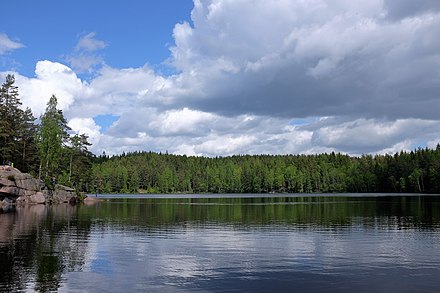 The easily accessible nature and many trails are just a short boat, metro, or bus ride away from anywhere in the city. Both in the inner city and especially in the forests of southern and northern Oslo there are countless hiking and cycling opportunities.
The easily accessible nature and many trails are just a short boat, metro, or bus ride away from anywhere in the city. Both in the inner city and especially in the forests of southern and northern Oslo there are countless hiking and cycling opportunities.
- Explore the Oslo forest (Marka). Oslo is surrounded by wide forested hills within reach metro, tram or pass. There hundreds of lakes, hills and small summits. There are fine roads and paths in these forests, hiking is possible everywhere, fine roads are accessible by bicycle, baby stroller and wheelchair. Nice gateways to the lovely nature are T-bane to Frognerseteren (line 1), Sognsvann (line 3), Romsås (line 5), Bogerud (line 3), Skullerud (line 3) or Ellingsrudåsen (line 2), or the train to Movatn or Snippen (local trains towards Hakadal, Roa, Jaren and Gjøvik). Also bus 56 from Torshov (tram 11, 12, 13 and bus 20) via Storo T-bane to Solemskogen or bus 51 from Nydalen (bus 37, T-bane 4, 5 and 6) to Maridalen offer many possibilities for walks and rural life, everything less than half an hour from the city centre. Bring something to drink and a chocolate bar (and do a bit of planning, buses 51 and 56 and the train does seldom run more than once per hour). Trails suitable for bicycles and strollers as well as hiking only can be found. Be prepared for some muddy sections of the trail as they take you through some pretty thickly wooded areas. Freshwater fishing (Trout, pike, perch, etc.) requires a fishing license.
- Discover the city and its major tourist sites by bike: from April through October, guided tours in English are available daily with Viking Biking.
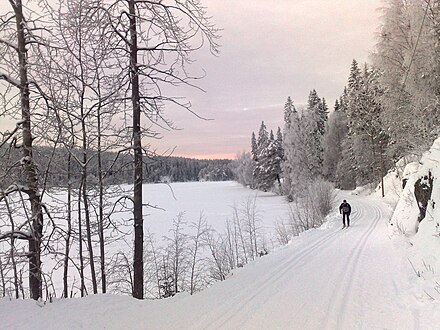
Snow activities
The ski season in Oslo is variable, but there may be enough snow and possibilities for good skiing conditions from December to early April. This is the darkest time of the year, but in Oslo the skiing days are extended by the fact that many ski trails and ski slopes are artificially lit.
- Skiing. The Oslo forest has a wide network of groomed cross-country trails. Trails begin at where the built-up area ends within metro, bus or tram from downtown Oslo. Cross-country skiing is popular among the people of Oslo and during winter skiers with gear are frequently seen in the streets.
- There are also ski-lifts and slopes for alpine skiing in the Oslo forest, such as Oslo Winter Park and Oslo Skisenter (Grefsenkollen) and the Tryvann Ski School for beginners.
- There are ski lifts and slopes in Bærum and Nittedal near the city. Within reasonable distance for a day trip, alpine alternatives are Kongsberg and Norefjell.
Festivals
Constitution day
Constitution Day, annually the 17th of May and therefore also known as syttende mai is a folk festival in Oslo. This is a day that is celebrated by the whole population and participation by foreigners is appreciated. Norwegians dress up in their finest clothes or various national dress costumes (bunad). Schoolchildren in Oslo have a parade that ends at the royal palace, where they wave, greeting the Royal Family on the balcony. Sellers of ice cream, kebabs, hot dogs and sausages have their best day. Adults without children continue the celebration.
Sports
- Ekebergsletta (bus 34 or 74) during Norway Cup (beginning of August every year), billed as the world's biggest football tournament (about 25,000 participants). Lots of fun and football. Held annually at the beginning of August.
Music
- Øyafestivalen in the Tøyen Park. In the beginning of August every year, Oslo's downtown is housing the Øyafestivalen, an event which over the years has become a great festival for all kinds of people of all ages who enjoy rock and pop music. http://oyafestivalen.com/
- Norwegian Wood. Rock festival. Takes place in the northern end of Frognerparken/Frognerbadet in early/mid-June. The lineup usually includes a number of international heavyweights like Eric Clapton, Patti Smith, Ringo Starr, Eagles (all in the 2011 lineup), and a selection of Norwegian bands.
- by:Larm. Rock festival taking place in various venues downtown Oslo, mid-February. The lineup consists of mostly Norwegian (or Nordic) underground or rising artists along with some more established names.
- Inferno. Inferno is a metal festival taking place in various venues downtown Oslo, late March. Dating back to the mid-1980s and the forming of bands like Mayhem, Norwegian Black Metal has established itself on the international stage. Where better to experience the sheer evil energy than in the dark and cold world capital of Black Metal; Oslo?
- Oslo Jazz Festival. Taking place mid-August in various venues, downtown.
- Oslo Chamber Music Festival. Founded by renowned violinist Arve Tellefsen in 1989. The programme usually spans from medieval to contemporary music. Over the years artists (in no particular order) like Barbara Hendricks, Jan Garbarek, the Hilliard Ensemble, Trio Mediæval, Solveig Kringlebotn, Elisabeth Norberg-Schulz and many others have performed.
- Musikkfest (National Music Day). Free, mostly outdoors, music festival established in Oslo in 1992, as a spinoff from Fête de la Musique. Always taking place first Saturday in June.
Other cultural festivals
- Oslo Pride (Skeive dager). Gay/lesbian pride festival and parade taking place all over, late June.
- Oslo Seafood Festival (dead link: January 2023)/Day of Coastal Culture (dead link: February 2023) held in front of the City Hall, early June.
- Films from the South. Film festival presenting movies from Asia, Africa, Middle East and Latin America. Established 1991. Takes place in various theatres in Oslo, mid-October. Arabian Film Days late April.
Markets
Learn
- University of Oslo, 59.9399801°, 10.7213768°. The biggest and oldest university in Norway. Main Department at Blindern.
- University of Oslo (The Faculty of Law), Karl Johans gate 47, 59.915652°, 10.7353761°. The oldest, most monumental buildings of the university.
- BI, 59.948714°, 10.768114°. A private business school offering a range of courses and degree programs (bachelor, master, PhD).
- Oslo Metropolitan University (Oslomet: Upgraded 2018 to a university, former names:Oslo University College, Høyskolen i Oslo), 59.921869°, 10.733406°. Teaches many different courses in English. International students, specifically, should look at the European Project Semester (dead link: December 2020).
Work
If you're looking for work check out the website of the governmental agency NAV or other sites like Topjobs (dead link: January 2023), Manpower, Stepstone, Jobzone and finn.no.
Citizens from outside the EEA area need a residence permit in order to work in Norway. This should be applied for at the Norwegian mission in your country of residence.
Buy
Oslo is one of the most expensive cities in the world. Still, there are possibilities for getting bargains in Oslo during the big sales. The prices on famous brands are not higher in Oslo than in London or Paris, often lower even if they are not on sale. The big sales are in January and August, sometimes in between. The norwegian word for reduced price is "Salg" or "Tilbud".
VAT refund/Tax Free Shopping
In a number of shops you can get a VAT refund cheque when leaving the country. Most of these shops carry a Tax Free logo displayed in the shop window or on their counter, but you are advised to ask the sales assistant whether tax free shopping applies to the shop in question, as not all shops carry the tax free logo.
If you use the tax free shopping service offered in these stores, you may receive a cash refund when leaving Norway. There are refund points at various locations in Norway, such as airports, road borders or onboard ferries and cruise ships. Which refund point you can use depends on how you leave the country.
The minimum purchase amount in one shop (to get a tax refund check) is 315 kr on regular goods and 290 kr on food. In Norway, sales tax/VAT is included in the retail price. Goods must be exported in unused condition within 30 days from date of purchase. When approaching the refund counter, please make sure you have your goods, refund cheque as well as your passport/ID card.
The tax refund service is not available for Norwegian, Swedish, Danish and Finnish residents.
Shopping districts
If you are out to shop there's plenty to choose from. The main pedestrian street Karl Johans gate has plenty of shops of dubious quality. The street Bygdøy allé (which is locally famous for its chestnut trees) (bus 20, 31) has regained its reputation of being a shopping street the past few years by establishments that focuses on kitchens, kitchenware, interior designs, exclusive Norwegian furniture, light design and others. The street Møllergata (downtown, public transport from stops Stortorget and Møllerveien at either end of the street) was earlier known as the furniture street. You will still find a few good, but rather expensive shops for Norwegian furniture in this street. You can easily find this street close to the Christiania Glasmagasin and the street Torggata which contains a few home interior shops like KID, Kitch´n, Habitat.
Eat
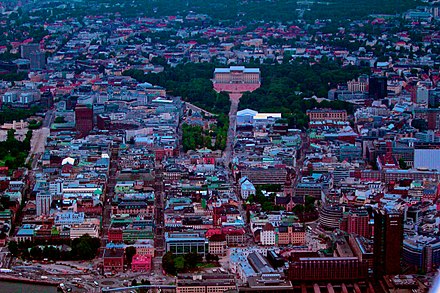
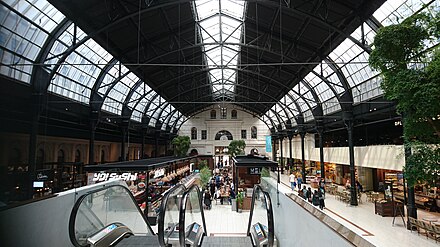
There are a lot of both expensive and cheap places to eat in Oslo. The cheapest restaurants are Asian restaurants which, in many cases, serve good food at low prices.
Check the menus on the door. Even though you should always use your eyes (and nose) in any food establishment, Norwegian Food and Health regulations are very strict and enforced effectively, so eating out in Oslo is safe.
Street snacks are also available throughout the city, but they're usually more expensive than in comparable cities elsewhere.
There are some restaurant chains with several locations throughout the city. For example, the 13 pizza restaurants (American style) in the Peppes Pizza chain which also have take-away service and delivery service.
Aker Brygge (tram 12, bus 21, 32, 33 or 54; stops Aker Brygge, Vika Atrium or Bryggetorget) is a waterfront located south of the city hall. During summer the area is very noisy and vibrant. There are outdoor restaurants and bars almost everywhere. Be sure to get some tasty seafood (or whatever else you like to eat) while you are there, or just enjoy your cold beer in the summer sea-breeze. This is the most expensive area in Oslo to dine or drink, so unless the weather is good, you can just as well stay indoors somewhere else.
Sven's, located near Vika Atrium, offers a fast food version of a traditional dietary staple - lutefisk. Sides include herring, pickled vegetables, and salted meats. Because of the amount of lye used to treat the food, be prepared to sign a waiver designating power of attorney upon entry. Closed Mondays.
You are also close to most of the restaurants, bars, or nightclubs located within the city centre. A key reference point will be Stortingsgaten, running parallel to Karl Johans gate, both running eastwards from the Royal Palace (this is also the main shopping area). While both of these streets have a few restaurants and nightclubs, most will be found in one of the side-streets running out from them, or parallel to them. It doesn't matter much where you start, you will find restaurants, bars, and nightclubs almost anywhere from the subway station Nationaltheatret at the west, to far beyond Oslo central railroad station on the east. There are several other areas, such as Grünerløkka (tram 11-12-13 to Nybrua, Schous plass, Olaf Ryes plass or Birkelunden), Majorstuen (T-bane, tram 11-12-19 or bus 20-22-25-45-46 to Majorstua), and Grønland (T-bane to Grønland, bus 37 to Tøyengata or bus 60 to Norbygata) that are worth checking out. Nearly all bars and nightclubs close at the same time, so if you want to get a taxi back to your hotel, try to leave a few minutes before the rush starts.
Budget
Torggata
Torggata is a good area for budget dining (from Hausmanns gate south to Youngstorget). You will find cheap Vietnamese, Thai, and Chinese restaurants and even cheaper kebab-joints and pizzerias, as well as other offerings. It's close to the centre, but you can get bus 34 or 54 to Jacob's church (Jacob kirke), or tram 11-12-13-17/bus 30-31-34-54 to Brugata or Hausmanns gate. The closest T-bane station is Grønland (then walk north along Brugata) or Jernbanetorget (then walk north-east).
Grønland
Grønland is full of cheap eating joints, shops selling fabrics and jewellery, Indian and Pakistani sweet shops, cheap beer and more. Several new restaurants and cafes around the Teaterplassen. Cozy Oslo Mekaniske Verksted sell drinks and you can bring your own food from one of the nearby take away.
Norwegian food
Most cafes and restaurants serving traditional food are upmarket, but there are a couple of good spots to get stuffed on meat cakes and brown gravy, lutefisk and other delicacies:
Elsewhere
You can always get your fix of sausage and kiosk-food at reasonable prices, but there are a few restaurants and cafés worth mentioning. The convenience stores and kiosk chains 7-Eleven and Deli de Luca will provide a choice of pastries, cakes, candy, refreshments and alternate 'snacks', many of which are over-priced and can be bought from a Rimi, Kiwi or Joker supermarket at a fraction of the price. When opting for the convenience stores, ask the staff how fresh the counter food is - where most produce is delivered in the morning and evening purchases may see the food lying there for up to 12 hours prior.
- Baker Hansen, various locations. Closed Sundays. A classical Norwegian bakery, offering sweet buns, pastries, cakes, bread, ready-made sandwiches, savoury pastries, seasonal items, and drinks. Most have a few seats, but you can easily take it away for a picnic or breakfast. Their skolebrød is particularly commendable. 14-50 kr for most items
Splurge
If price is no object, there is some very fine dining to be found. At the Grønland area you will find the only 3 stars Michelin restaurant; Maaemo. You will find other Michelin rated restaurants around Oslo in this list.
Drink
For more information on drinking in Norway, see the section Drink (Norway)
Buying alcohol in stores
Beer at 4.75% or below can be purchased in supermarkets at a price of 20-30 kr for a 0.5L can. Supermarkets stop selling beer after 20:00 each day, 18:00 on Saturdays, and 15:00 on holiday weekends. It is not possible to buy beer in a shop on a Sunday. It is illegal to drink in public areas. You will usually only get a warning if spotted by a police officer, if they even bother to bother you, but if you behave impolitely or s/he is having a bad day you can get a fine of 1,500 kr. However, in public parks during summer, laws are not enforced much at all. Good places to go for a park beer are Sofienbergparken and Kuba at Grünerløkka, Frognerparken in Majorstua, or the park at St. Hanshaugen, on a hill with great view located between Grünerløkka and Majorstuen.
Hard liquor, wine and beers above 4.75% ABV can only be bought at the state-owned shops called Vinmonopolet or at the international airport terminals. Vinmonopolet outlets are open M-F until 18:00, Sa 15:00, Su closed. Some of the central Vinmonopolet outlets in Oslo are:
- Oslo Central Station, beneath the staircase leading down to Trafikanten
- In the basement of Oslo City shopping centre
- In the Steen og Strøm shopping centre, close to Karl Johans gate
- Rosenkrantzgate 11, close to Grand Hotel, Karl Johans gate
- At Aker Brygge, Bryggegata 9. This shop has been relocated from Vika and has the same large selection of beers. (Tram 12 or you can take one of several buses that stop in Dokkveien or Vika Atrium).
- Thereses gate, Bislett (near Bislett stadium, trams 17 and 18)
- Tøyengata 2, Grønland Basar. (All eastern subways, exit at Grønland Torg or bus 37 to Tøyengata)
Pubs and bars
All bars, pubs and restaurants in Oslo are smoke-free, which means you have to go outside to smoke. But since you can't drink on the street, you have to leave your drink inside, unless the bar/pub has a designated drink-area which is still open (they always close earlier than the venues themselves).
Oslo is generally expensive. The price for a half-litre of beer is typically ranging from 58-70 kr. Closing hours are as late as to 03:30 in city centre. National legislation says you can't serve any alcohol after 03:00.
Areas with notable pub density are Grünerløkka (tram 11-12-13 to Nybrua, Schous plass, Olaf Ryes plass or Birkelunden), Aker Brygge (tram 12 to Aker Brygge or bus 21-32-33-54 to Vika Atrium or Bryggetorget), Solli/Frogner (tram 12-13 or bus 30-31 to Solli), Grønland (T-bane to Grønland, bus 37 to Tøyengata or bus 60 to Norbygata) and the city centre especially Youngstorget or Grensen.
Norwegian beer is worth exploring. In addition to the major breweries in Oslo, Ringnes and Frydenlund, there are a number of local, smaller breweries that brew high-quality craft beers.
Sleep
There are several hotels, hostels in Oslo. Normally it is okay to find a room, but can be difficult when it is peak time during conferences, concerts, sports events etc. There are also a few youth hostels to stay at or you can consider staying with the locals via Airbnb. Affordable/budget accommodation is available outside the inner city center (Sentrum).
At Oslo Airport
Camping
Campings are available at year round Bogstad Camping and at Ekeberg Camping.
Connect
Internet access
Most of the hotels offer free Wi-Fi.
Most of the internet cafes are located in the city center or eastern part of town. Look for small shops selling telephone cards - they usually have internet terminals.
If you carry your own device WLANs will be easy to find at cafes, hotels, bars, museums, supermarkets and even in parks.
Stay safe
Emergency numbers
- Police (Emergency only), 112. If you are unsure which emergency number to call, 112 is the central for all such rescue services and will put you in contact with the correct department.
- Police (non-emergencies), 02800 (in country only), +47 22 66 90 50 (Oslo Police District).
- Fire (Emergency only), 110.
- Emergency Medical Services (Ambulance), 113.
Crime
Oslo is generally a safe city, but as in any metropolitan area, some caution is warranted. Violent crime is rare, but not unheard of. Avoid getting in to quarrels in taxi queues after closing hours of bars. Avoid groups of drunk young men. The police advise that the area along the Akerselva river from Grønland to Cuba is best avoided after dark. It is known for instances of rape, muggings and drug dealing. Though Oslo isn't as dangerous as many places around the world, there are a few working-class areas that many locals would advise people not to visit at night, some of which are: Stovner, Holmlia, and Grønland/Tøyen. The chances of your getting mugged or robbed in these areas aren't extremely high, but it's not worth taking the risk.
Women should remain vigilant at night and when clubs and pubs are closing. Avoid walking alone through parks and poorly lit areas of the city. Do not, under any circumstances, use “pirate taxis” or other unofficial transportation.
Theft and pick pocketing is a nuisance. Normal precautionary rules apply:
- Watch out for pick pockets in crowds and public transport.
- Do not leave your belongings unattended.
- Avoid leaving your mobile phone and wallet on café tables.
If you are yourself subject to criminal acts, or witness a crime, it is generally accepted to report or tip it to the police. It is a welcome contribution to better public safety.
Scams
Common scams are rare but occur in Oslo as in any big city. In 2008 there were reports on the "guessing game" being perpetrated on the street - don't get involved in street-betting as it is certain to be a scam.
Winter conditions
For more information on driving in winter conditions, see the Winter driving article.
Pay particular attention to winter conditions when driving, and make sure your car has winter tyres. The roads and streets of Oslo can be very slippery, especially if there is a lack of snow clearing and gritting, so drive slowly and carefully.
In winter watch out for icy patches, and when wandering in the forest beware when crossing snowy clearings - they may well be frozen lakes with snow over them, which may look safe but could crack. Before you walk on the ice on lakes, make absolutely sure the ice is carrying you. Drowning accidents occur. Finally, beware of heavy snow and icicles falling from the roofs in temperatures just above the freezing point. In Oslo there are usually red/yellow signs upwards, and some areas are occasionally cordoned off.
Politics
Politics is not a sensitive subject in Norway, and is often discussed in public, although if you do not support a mainstream political party that has representation in the Parliament like Høyre (Conservative Party) or Arbeiderpartiet (Labour Party), your opinion might lead to confusion and controversy. Like in other western countries, political views differ, and most people tolerate this. There are even far-left opinions in the everyday crowd, but true extremism is rare. Pay normal attention when expressing your political opinions; violent and autocratic ideologies are generally not tolerated in Norway. In addition, being a highly diverse city, racism and sexism is generally not tolerated among Osloers. In environmental policies, Norwegians have a fairly European-minded attitude when climate issues are discussed, but fewer people (including activists) will be vegetarian. Sensitive issues include the Second World War, religion, race and the July 22nd atrocities. "Race" is not an accepted term. Environmental issues such as whaling may also be sensitive and many Norwegians think it is perfectly fine to hunt whales for food.
Water
Oslo has high quality tap water, so there is no need to buy expensive bottled water.
In front of the city hall, near the harbour, you will find a drinking water station.
As always, boil water obtained from lakes, rivers, streams and other untreated sources of water if trekking or camping in the Oslo forest (Marka). Do not obtain water from ponds, large puddles and other bodies of standing water.
Dangerous animals
There are few wild animals that can hurt. However, some people get wasp stings and tick bites that may transmit Borrelia. In case of complications, consult a doctor. The only poisonous snake is the common European adder. In case of an adder bite, seek medical attention immediately. Adder bites are very rare, because the adder is a shy creature.
Safety at sea
Every year there are reports of foreign visitors that get into trouble in small boats at sea. In the Oslofjord area, fatal incidents also occur. Life jackets are required and the usual marine traffic rules are followed. If piloting a boat, keep a low speed in the archipelago and don't drink. On public ferries and liner boats, familiarize yourself with the safety rules on board, which are usually available in English.
Traffic
_2019-01-13.jpg/440px-Map_of_Cycling_infrastructure_in_Oslo,_Norway_(Gang-_og_sykkelruter_i_Bj%C3%B8rvika,_Oslo._Kart_p%C3%A5_skilt_ved_Eufemias_gate_og_Nordenga_bru._Sykkelvei,_sykkelbane.)_2019-01-13.jpg)
For more information on driving in Norway, see the Driving in Norway article.
Cars are required to yield to pedestrians at marked and signed crossings, and will be heavily fined if they don't. However, this rule does not apply to trams (streetcars); the trams have the right of way. Oslo has a web of tram lines downtown and as the trams are fast and heavy, you will certainly lose if you attempt to challenge one. Keep your distance from trams, especially when they turn. Traffic in streets is generally slow and safe, 40 km/h is standard speed except on main roads without pedestrians.
Oslo is not one of the most suitable cities for driving and navigation is complicated particularly downtown. In central Oslo it is recommended to travel by public transport. Public transport in Oslo is well developed, it saves time and minimises pollution. Driving requires high level of attention all the time. There is little on-street parking in central Oslo, and many pedestrian streets, dead ends and one-way streets. Free parking is not common, and off-street parking is expensive. Rush hour traffic jams are common.
The main roads are well signposted.
Stay healthy
In acute illness or if accident occurs:
- Emergency Medical Services, 113 (Emergencies only).
- Oslo legevakt, 116 117 (in country only), +47 22 93 22 93 (Storgata 40). For non-emergency injuries and illness (emergency room/physician seeing patients without appointment).
There are many pharmacies (apotek) in Oslo, that are selling medications and can give you advice on the treatment of injury and disease Vitusapotek Jernbanetorget (Jernbanetorget 4 B) is open 24/7.
Cope
It is easy to get around in Oslo, and almost every Norwegian speaks English. Most people will respond in English to any question you may have. Many Norwegians also speak some German, Spanish or French, due to having studied them in school. Information on public transport and in government offices is often printed in English. Some bars or cafes operate in English.
Visa and MasterCard are normally accepted in any restaurant, taxi or store. ATMs accept all major credit and debit cards and are available in English language. The currency is Norwegian kroner (crowns).
Most hotels and a number of restaurants offer free Wi-Fi, and there are still a number of internet cafes.
Norwegian language
For more information on the most common phrases in Norwegian, see the Norwegian phrasebook article.
Norwegian (norsk) is a North Germanic language spoken mainly in Norway. However, Norwegian has many similarities with the other Scandinavian languages: Swedish and Danish. In Norway there are many Norwegian dialects, all present in the capital. Dialects have large variations in tone and many local dialect expressions. Nevertheless, it appears that all Norwegians understand each other. Although it is relatively easy to communicate with Norwegians in English, it might be useful to learn some common Norwegian phrases.
Budget travellers
The Youth information (Unginfo (dead link: December 2020)) runs an independent information desk in Møllergata aimed at budget travellers. This service is free and they also provide free internet access. There is an online guide to Oslo for budget travellers on their web site.
Embassies
| | | | style="vertical-align:top;width:50%;" | - 🇦🇫 Afghanistan, Gange-Rolvs gate 5, +47 22 42 06 40. - 🇩🇿 Algeria, Inkognitogata 37, +47 22 55 75 31. - 🇦🇷 Argentina, Drammensveien 39, +47 22 55 24 48. - 🇦🇹 Austria, Thomas Heftyesgate 19-21, +47 22 54 02 00. - 🇧🇪 Belgium, Drammensveien 103 D, +47 23 133 220. - 🇧🇦 Bosnia and Herzegovina, Drammensveien 105, +47 22 55 27 50. - 🇧🇷 Brazil, Sigurd Syrs gt 4, +47 22 54 07 30. - 🇧🇬 Bulgaria, Tidemanns gate 11, +47 22 55 40 40. - 🇧🇮 Burundi, Oscars gata 57,, +47 21385782. - 🇨🇦 Canada, Wergelandsveien 7 (4th floor), +47 22 99 53 00, oslo@international.gc.ca. - 🇨🇱 Chile, Meltzersgate 5, +47 22 44 89 55. - 🇨🇳 China, Holmenveien 5, 59.9429876°, 10.7018456°, +47 21 42 08 80. - 🇨🇷 Costa Rica, Skippergata 33, +47 22 42 58 23. - 🇭🇷 Croatia, Drammensveien 82, +47 23 08 32 60. - 🇨🇺 {{listing | name=Cuba | url=http://www.cubadiplomatica.cu/noruega/EN/Home.aspx (dead link: December 2020) | email= | address=Oscars gate 78B | lat= | long= | directions= | phone=+47 22 44 22 33 | tollfree= | fax= | hours= | price= | content= }} - 🇨🇿 Czech Republic, Fritzners gate 14, +47 22 12 10 30. - 🇩🇰 Denmark, Olav Kyrres gate 7, +47 22 54 08 00. - 🇪🇬 Egypt, Drammensveien 90 A, +47 23 08 42 00. - 🇪🇪 Estonia, Parkveien 51 A, +47 22 54 00 70. - 🇫🇮 Finland, Thomas Heftyes gate 1, +47-2212 4900, sanomat.osl@formin.fi. M-F 09:00-12:00, 12:30-16:00. - 🇫🇷 France, Drammensveien 69, +47 23 28 46 00. - 🇬🇪 Georgia, Pilestredet 15B, +47 23 20 16 99. - 🇩🇪 Germany, Oscars gate 45, +47 23 27 54 00, +47 23 27 54 08 (for passports), info@oslo.diplo.de. - 🇬🇷 Greece, Nobels gate 45, +47 22 44 27 28, +47 22 43 12 21, gremb@online.no. - 🇬🇹 Guatemala, Drammensveien 126 B, +47 22 55 60 04. - 🇮🇸 Iceland, Stortingsgaten 30, +47 23 23 75 30. - 🇮🇳 {{listing | type=listing | name=India | alt= | url=http://www.indemb.no/ (dead link: December 2020) | email= | address=Niels Juels gate 30 | lat=59.9142343 | long=10.7112379 | directions= | phone=+47 24 11 59 10 | tollfree= | hours= | price= | content= }} - 🇮🇩 Indonesia, Fritzners gate 12, +47 22 12 51 30, oslo.kbri@kemlu.go.id. * {{listing | name=Iran | url=http://iranembassy.no/public_html/en/index.htm (dead link: August 2020) | email= | address=Drammensveien 88E | lat= | long= | directions= | phone=+47 23 27 29 60 | tollfree= | fax= | hours= | price= | content= }} - 🇮🇪 Ireland, Haakon VII's gate 1, 59.9131963°, 10.7317308°, +47 22 01 72 00. | style="vertical-align:top;width:50%;" | | - 🇮🇱 Israel, Parkveien 35, +47 21 01 95 00. - 🇮🇹 Italy, Inkognitogaten 7, +47 23 08 49 00. - 🇯🇵 Japan, Wergelandsveien 15, +47 22 99 16 00. - 🇰🇿 Kazakhstan, Nedre Vollgate 3 (2nd floor), +47 22 42 06 40. - 🇱🇻 Latvia, Bygdøy Allé 76, +47 22 54 22 80. - 🇱🇹 Lithauania, Dronningens gate 3, +47 22 12 92 00. - 🇲🇰 Macedonia, Erling Skjalgssonsgate 19 B, +47 22 55 15 44. - 🇲🇦 Morocco, Erling Holtegata 28, +47 23 19 71 50. - 🇳🇱 Netherlands, Oscars gate 29, +47 23 33 36 00. - 🇵🇰 Pakistan, Eckersbergs Gate 20, +47 23 13 60 80. - 🇵🇭 Philippines, Nedre Vollgate 4, 59.91105°, 10.7380324°, +47 22 40 09 00. - 🇵🇱 Poland, Nedre Vollgate 5, +47 21 03 72 00. - 🇷🇴 Romania, Oscars gate 51, +47 22 44 15 12, oslo@mae.ro. 2021-12-03 - 🇷🇺 Russian Federation, Drammensveien 74, +47 22 55 32 78. - 🇸🇦 Saudi Arabia, Frøyas gate 11, +47 22 04 90 10. - 🇷🇸 Serbia, Munkedamsveien 59B, +47 23 11 52 20. - 🇸🇰 Slovakia, Thomas Heftyes gate 24, +47 22 04 94 70. - 🇿🇦 South Africa, Drammensveien 88 C, +47 23 27 32 20. - 🇸🇸 South Sudan, Prinsessealléen 2, +47 22 44 99 39. 09:00-16:00. - 🇪🇸 Spain, Havdan Svartes gate 13, +47 22 92 66 80. - 🇱🇰 Sri Lanka, Sjølyst Plass 4, +47 23 13 69 50. - 🇸🇩 Sudan, Holtegata 28, +47 21 38 96 36. - 🇸🇪 Sweden, Nobels gate 16, +47 24 11 42 00. - 🇨🇭 Switzerland, Bygdøynesveien 13, +47 22 54 23 90. * Taiwan, Kronprinsens gate 5, 5th Floor,, +47 23 11 17 30. - 🇹🇭 Thailand, Eilert Sundts gt. 4, +47 22 12 86 60. - 🇹🇷 Turkey, Halfdan Svartes gate 5, +47 22 12 87 61. - 🇺🇦 Ukraine, Arbins gate 4, +47 22 83 55 60. - 🇬🇧 United Kingdom, Thomas Heftyes gate 8, +47 23 13 27 00. - 🇺🇸 United States, Morgedalsvegen 36 (Metro line 2 to Makrellbekken Station), 59.9413969°, 10.6690727°, +47 21 30 85 40. * {{listing | name=Venezuela | url=http://www.venezuela.no/index.html (dead link: December 2020) | email= | address=Drammensveien 82 | lat= | long= | directions= | phone=+47 22 43 06 60 | tollfree= | fax= | hours= | price= | content= }} * Vietnam, St. Olavs gate 21C, +47 22 20 33 01. |
- <small>🇦🇺 The Australian consulate is closed, and Australian citizens should seek consular assistance from the embassy in Copenhagen, Denmark.</small>
- <small>🇳🇿 New Zealand citizens seeking consular assistance should do so from the New Zealand embassy in The Hague, The Netherlands.</small>
See also complete list of foreign consulates and embassies in Norway.
Go next
- Oslomarka is the large forest surrounding the city. This is an important recreational area for the citizens of Oslo, and quite unique for a capital. Take the T-bane to Holmenkollen (line 1), Frognerseteren (line 1), Sognsvann (line 3) or Skullerud (line 3 - in the opposite direction of Sognsvann), bus 41 from Røa T-bane to Sørkedalen or bus 51 from Nydalen T-bane to Maridalen. You can also visit the tourist association at Storgata (at Kirkeristen tram stop) for good maps and inexpensive accommodation alternatives in Oslomarka. Detailed online maps available at ut.no.
- Tusenfryd Amusement Park, the largest amusement park in Norway, is a 20-minute bus ride from central Oslo on Bus route no. 500 or route no. 521 from Ski Railway Station. Carousels, roller coasters, ghost castle, etc. (By car: From the exit at the European routes E6 / E18 at Vinterbro, southeast of Oslo: Follow the signs to Tusenfryd).
Further afield
- Kongsberg is a beautiful city well known for its 300 years silver mining history. The city is about an hour and a half west of Oslo by train or bus. The Kongsberg International Jazz Festival is hosted here every year in early July. Skiing Winter time: one of Norway's well-known winter sports resorts.
- Fredrikstad is a very enjoyable city not far from Oslo, with an old, walled old town (a fortress in fact) and lots of streetlife in summer. Trains run approx every hour (taking 1hr 10min), and express buses run about 10 times per day (1hr 30min).
- Tønsberg is an attractive seaside town with an attractive city centre. It's the oldest town in Norway, and even if this isn't instantly visible, there's lots of history to digest. Excellent highways will take you to the city in an hour from Oslo. The train uses around two.
- Drøbak is another of the picturesque, small seaside towns dotted all over southern Norway, and the closest to Oslo. Nice place to get away from the big city bustle, even if Drøbak also can become crowded in summer. Buses run at least hourly. Ferry from Oslo (Aker Brygge) via Nesodden in the summertime.
- Son (pronounced soon) is also one of the coastal pearls. Get local train to Moss, alight at Sonsveien station, and get the bus that meet most trains. Son is a small, picturesque 'artist town', because many well-known painters and writers have resided there. Good restaurants.
- Drammen was earlier an unremarkable industrial city dubbed "the biggest road crossing of Norway". Even if traffic is still rife, the city has gone through a face lift, and the centre is as cosy as any. TimEkspressen bus line 1 (every hour, day and night) and 10, and 3 trains an hour gets you there and away.

